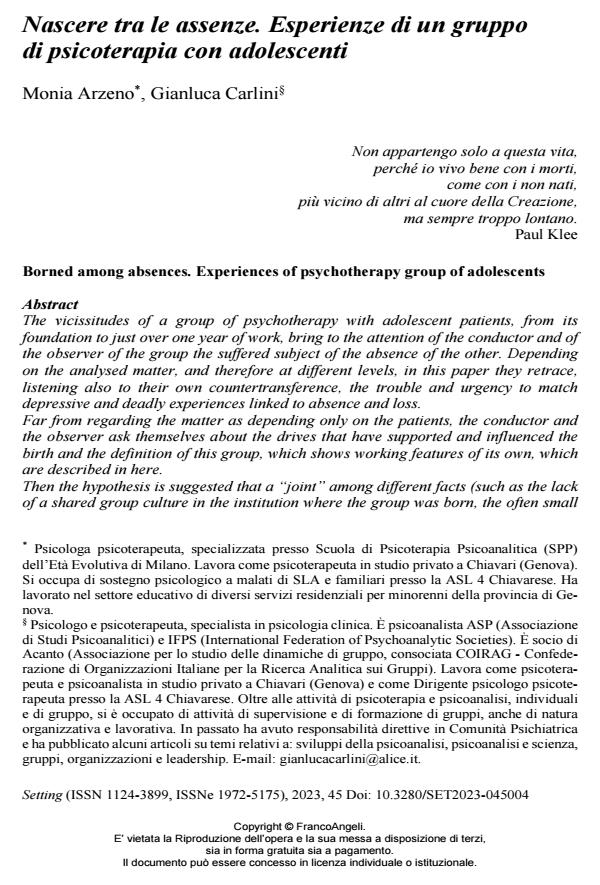Borned among absences. Experiences of psychotherapy group of adolescents
Journal title SETTING
Author/s Monia Arzeno, Gianluca Carlini
Publishing Year 2023 Issue 2023/45 Language Italian
Pages 17 P. 45-61 File size 197 KB
DOI 10.3280/SET2023-045004
DOI is like a bar code for intellectual property: to have more infomation
click here
Below, you can see the article first page
If you want to buy this article in PDF format, you can do it, following the instructions to buy download credits

FrancoAngeli is member of Publishers International Linking Association, Inc (PILA), a not-for-profit association which run the CrossRef service enabling links to and from online scholarly content.
The vicissitudes of a group of psychotherapy with adolescent patients, from its foundation to just over one year of work, bring to the attention of the conductor and of the observer of the group the suffered subject of the absence of the other. Depending on the analysed matter, and therefore at different levels, in this paper they retrace, listening also to their own countertransference, the trouble and urgency to match depressive and deadly experiences linked to absence and loss. Far from regarding the matter as depending only on the patients, the conductor and the observer ask themselves about the drives that have supported and influenced the birth and the definition of this group, which shows working features of its own, which are described in here. Then the hypothesis is suggested that a "joint" among different facts (such as the lack of a shared group culture in the institution where the group was born, the often small number of participants, the histories of the patients scattered with dropouts and also the tasks of adolescent development itself) have resulted in and allowed the group, if not to work through the matter of the absence of the other, at least to push on presenting it in different times and with different languages (interactions among participants, actings out, movie storytelling,…), aiming to expand increasingly broader areas of thinkability.
Keywords: group, psychotherapy, adolescence, absence, foundation, thinkability.
- Ambrosiano L., Gaburri E. (2013). Pensare con Freud. Milano, Raffaello Cortina.
- Anzieu D. (1983). Progrès et problèmes e théorie des groupes. Bulletin de Psychologie, XXXVII(363).
- Bion W. R. (1972). Apprendere dall’esperienza. Roma: Armando.
- Correale A. (1991). Il campo istituzionale. Roma: Borla.
- Ferro A., Civitarese G. (2015). Il campo analitico e le sue trasformazioni. Milano: Raffaello Cortina.
- Merletti R. V., Tognolini B. (2006). Leggimi forte. Milano: Salani.
- Miglietta D. (2007) (a cura di). Bambini e adolescenti in gruppo. Roma: Borla.
- Neri C. (2017). Gruppo. Milano: Raffaello Cortina.
- Nicolle O., Kaës R. (2008) (a cura di). L’istituzione in eredità. Roma: Borla.
- Ogden T. H. (2008). L’arte della psicoanalisi. Sognare sogni non sognati. Milano: Raffaello Cortina.
- Preta L. (1997). I nuovi paradigmi scientifici: modelli operativi per la psicoanalisi. In: Gaburri E. (a cura di). Emozione e interpretazione. Torino: Bollati Boringhieri.
- Riolo F. (1997). Il modello di campo in psicoanalisi. In: Gaburri E. (a cura di). Emozione e interpretazione. Torino: Bollati Boringhieri.
Monia Arzeno, Gianluca Carlini, Nascere tra le assenze. Esperienze di un gruppo di psicoterapia con adolescenti in "SETTING" 45/2023, pp 45-61, DOI: 10.3280/SET2023-045004